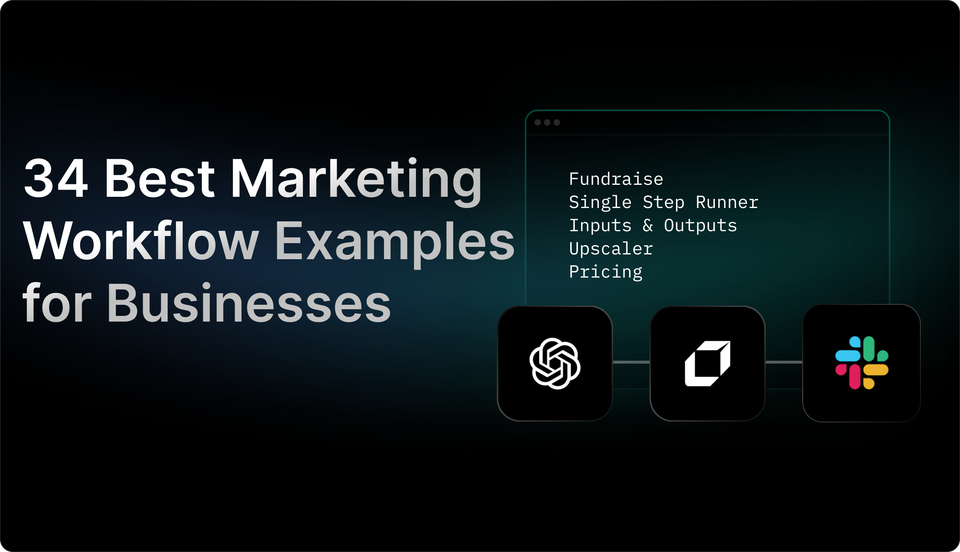25 Best Content Marketing Workflows (& Automating Workflows With AI)
Explore seamless content marketing workflows for optimal efficiency. Boost engagement and conversions with strategic planning and execution.

In the fast-paced world of digital marketing, where content is king and strategy reigns supreme, having a well-organized and efficient content marketing workflow is essential. From brainstorming and ideation to creation and distribution, a seamless workflow can make all the difference in achieving your marketing goals. In this blog, we will delve into the fascinating realm of content marketing workflows, uncovering the secrets to creating compelling content that captivates audiences and drives results.
Marketing workflow is an intricate dance, where each step must be meticulously choreographed to ensure a flawless performance. From the initial research and planning stage, where ideas are conceived and strategies are devised, to the execution phase, where content is brought to life and unleashed upon the digital landscape, every step is crucial. We will explore the key components of an effective content marketing workflow, shedding light on the tools, techniques, and best practices that can elevate your marketing game to new heights.
So, buckle up and get ready to embark on a journey through the world of content marketing workflows. Whether you're a seasoned marketer looking to fine-tune your existing workflow or a novice eager to learn the ropes, this blog is your ultimate guide to mastering the art of content marketing. Join us as we unravel the mysteries, explore the possibilities, and uncover the secrets to creating impactful content that leaves a lasting impression. It's time to step into the spotlight and take your marketing workflow to the next level.

What Is A Content Marketing Workflow?

Content marketing has become an integral part of any successful marketing strategy. In order to effectively plan, create, distribute, and measure the impact of content, businesses need a structured and streamlined process. This is where content marketing workflows come into play.
A content marketing workflow is a systematic and repeatable process that guides the creation, management, and distribution of content. It provides a framework for content teams to collaborate, ensures consistency, and helps maintain quality standards throughout the content creation journey.
Content Marketing Workflow Stages
1. Planning and Strategy Development
The first stage of a content marketing workflow is planning and strategy development. This involves defining goals, identifying target audience personas, conducting keyword research, and outlining the overall content strategy. This stage sets the foundation for all subsequent steps and ensures alignment with business objectives.
2. Content Creation
Once the strategy is in place, the content creation stage begins. This involves brainstorming ideas, conducting research, and developing a content calendar. Content creators collaborate with subject matter experts to produce engaging and informative content that resonates with the target audience. This stage also includes the writing, designing, and editing processes.
3. Approval and Review
After the content is created, it goes through an approval and review process. This stage involves ensuring that the content meets the brand's voice, style, and quality standards. Editors and stakeholders review the content for accuracy, grammar, relevance, and compliance with brand guidelines. Feedback is incorporated, and revisions are made if necessary.
4. Publishing and Distribution
Once the content is approved, it is ready for publishing and distribution. This stage includes formatting the content, optimizing it for SEO, and uploading it to the appropriate platforms such as websites, blogs, social media channels, and email newsletters. The content is scheduled for publication based on the content calendar.
5. Promotion and Amplification
To maximize the reach and impact of the content, promotion and amplification come into play. This stage involves leveraging various channels and tactics to promote the content, such as social media advertising, influencer outreach, guest blogging, and email marketing. The goal is to generate traffic, increase engagement, and drive conversions.
6. Measurement and Analysis
The final stage of a content marketing workflow is measurement and analysis. This involves tracking key performance indicators (KPIs), such as website traffic, engagement metrics, conversion rates, and revenue generated. Analytics tools are used to gather data, which is then analyzed to evaluate the success of the content marketing efforts. Insights gained from this analysis inform future content strategies and optimizations.
Benefits of Implementing a Content Marketing Workflow
Implementing a content marketing workflow brings several benefits to businesses:
1. Efficiency
A structured workflow ensures that content creation and distribution processes are streamlined, minimizing errors and saving time.
2. Consistency
With defined guidelines and standards, content consistency can be maintained across multiple channels and platforms.
3. Collaboration
A workflow encourages collaboration among team members, fostering creativity and knowledge sharing.
4. Scalability
A well-defined workflow allows businesses to scale their content marketing efforts as they grow, without compromising quality.
5. Measurable Results
By tracking and analyzing performance metrics, businesses can gain insights into the effectiveness of their content marketing strategies and make data-driven decisions.
A content marketing workflow provides a structured approach to content creation and distribution. It guides businesses through the planning, creation, approval, publishing, promotion, and measurement stages, ensuring efficiency, consistency, collaboration, scalability, and measurable results. By implementing a content marketing workflow, businesses can optimize their content marketing efforts and achieve their marketing goals.

Related Reading
What Does A Good Content Marketing Workflow Look Like?

Content marketing is a vital component of any successful marketing strategy, enabling businesses to engage with their target audience, build brand awareness, and drive conversions. Without an efficient content marketing workflow in place, businesses may find themselves struggling to produce high-quality content consistently.
We will explore what a good content marketing workflow looks like and how it can benefit your organization. From ideation to distribution, each step plays a crucial role in creating compelling and effective content.
1. Strategy Development: Laying the Foundation
A well-structured content marketing workflow always begins with strategy development. This involves conducting market research, identifying target audience personas, and defining clear goals and objectives. By aligning your content marketing efforts with your overall business objectives, you ensure that every piece of content serves a purpose and contributes to your desired outcomes.
2. Ideation and Creation: Nurturing Creativity
Once the strategy is in place, it's time to brainstorm and generate ideas for your content. This can involve brainstorming sessions with your team, conducting keyword research to identify popular topics in your industry, or monitoring industry trends and news. The key is to foster creativity and encourage diverse perspectives to ensure a constant flow of fresh and engaging ideas.
Once your ideas are solidified, it's time to move on to the creation stage. This involves developing an editorial calendar, assigning tasks to team members, and creating high-quality content that aligns with your brand voice and resonates with your target audience. Collaboration and effective communication are crucial during this stage to ensure smooth progress and timely delivery.
3. Optimization and Review: Fine-Tuning for Success
Creating content is just the first step; the next is to optimize it for maximum impact. This involves conducting thorough keyword research and incorporating relevant keywords into your content to boost search engine visibility. Optimizing meta tags, headlines, and images can enhance the overall searchability and clickability of your content.
Regularly reviewing your content for accuracy, grammar, and overall quality is also essential. This can involve multiple rounds of editing and proofreading to ensure that your content is error-free, well-structured, and meets your brand's standards. Reviewing your content not only enhances its quality but also helps you identify areas for improvement in your content creation process.
4. Distribution and Promotion: Reaching Your Audience
Creating great content is only half the battle; it's equally important to ensure that it reaches your target audience. This involves developing a comprehensive distribution and promotion strategy to maximize the visibility and reach of your content.
Utilizing various channels such as social media, email marketing, influencer partnerships, and guest blogging can help you amplify your content's reach and engage with your audience on multiple platforms. By strategically promoting your content, you increase the likelihood of it being discovered and shared, driving traffic back to your website and generating leads.
5. Monitoring and Analysis: Measuring Success
A good content marketing workflow doesn't end with content creation and distribution; it also includes monitoring and analyzing your content's performance. This involves tracking key metrics such as website traffic, engagement rates, conversions, and social media shares to gauge the effectiveness of your content marketing efforts.
Analyzing these metrics provides valuable insights into what works and what doesn't, allowing you to make data-driven decisions and continuously optimize your content marketing strategy. By regularly monitoring and analyzing your content's performance, you can identify trends, adjust your strategy as needed, and ensure that your content consistently delivers the desired results.
A good content marketing workflow encompasses strategy development, ideation and creation, optimization and review, distribution and promotion, and monitoring and analysis. By implementing an efficient workflow, businesses can streamline their content creation process, improve content quality and consistency, and ultimately achieve their marketing goals. So don't underestimate the power of a well-structured content marketing workflow – it's the secret ingredient to successful content marketing.
Related Reading
- Content Marketing Workflow
- Marketing Workflow Management
- Marketing Automation Workflows
- Digital Marketing Agency Workflow
- Digital Marketing Workflows
- Marketing Workflow Examples
25 Best Content Marketing Workflows

Content marketing is a crucial aspect of any software business's growth strategy. To effectively manage and streamline content production, it is important to implement well-defined workflows. Here are 25 content marketing workflows that can help software businesses create and distribute compelling content:
1. Topic Ideation and Research Workflow
This workflow involves researching and selecting relevant and engaging topics for the software business's content. Conducting keyword research, competitor analysis, and staying up-to-date with industry trends can help generate effective content ideas.
2. Content Planning and Editorial Calendar Workflow
Organizing content creation and publication schedules through a comprehensive editorial calendar ensures a consistent flow of content. This workflow involves brainstorming ideas, assigning tasks to team members, and setting publication dates.
3. Content Creation Workflow
The content creation workflow involves the actual writing or creation of the content. It includes tasks such as writing, designing, and editing content to ensure it meets the software business's quality standards.
4. SEO Optimization Workflow
Optimizing content for search engines is essential to increase visibility and drive organic traffic. This workflow involves keyword research, on-page optimization, and meta tag optimization to improve search engine rankings.
5. Content Review and Approval Workflow
Before publishing content, it is crucial to have a review and approval process in place. This workflow ensures that all content is checked for accuracy, consistency, and adherence to brand guidelines.
6. Content Publishing Workflow
Once content is approved, it needs to be published on various platforms and channels. This workflow involves formatting content, scheduling posts, and optimizing content for specific platforms such as websites, social media, and newsletters.
7. Social Media Promotion Workflow
Promoting content on social media platforms is essential for reaching a wider audience. This workflow involves creating social media posts, scheduling them, and engaging with the audience to drive traffic and engagement.
8. Email Marketing Workflow
Email marketing plays a crucial role in nurturing leads and retaining customers. This workflow involves creating email campaigns, segmenting the audience, and analyzing email performance to improve engagement and conversions.
9. Guest Blogging Workflow
Collaborating with industry influencers and thought leaders through guest blogging can expand the software business's reach. This workflow includes identifying potential guest blogging opportunities, pitching ideas, and writing high-quality guest posts.
10. Video Content Workflow
Video content is highly engaging and can help software businesses showcase their products or provide tutorials. This workflow involves scripting, filming, editing, and promoting video content on platforms like YouTube and social media.
11. Webinar Workflow
Webinars are effective tools for educating and engaging with the software business's target audience. This workflow includes planning, promoting, and hosting webinars, as well as following up with attendees for further engagement.
12. Case Study Workflow
Case studies provide social proof and demonstrate the software business's value to potential customers. This workflow involves identifying suitable clients, conducting interviews, and creating compelling case studies that highlight the benefits of the software.
13. Infographic Workflow
Infographics are visually appealing and can effectively communicate complex information. This workflow involves researching data, designing visually engaging infographics, and promoting them on relevant platforms.
14. Podcast Workflow
Podcasts offer an opportunity to share valuable insights and engage with the software business's audience. This workflow includes planning episodes, recording, editing, and promoting podcast episodes on various platforms.
15. Content Repurposing Workflow
Repurposing existing content into different formats helps maximize its reach and extend its lifespan. This workflow involves identifying content suitable for repurposing, adapting it into different formats, and distributing it on relevant channels.
16. Influencer Outreach Workflow
Collaborating with influencers can help software businesses expand their reach and credibility. This workflow involves identifying relevant influencers, reaching out to them, and establishing mutually beneficial partnerships.
17. User-Generated Content Workflow
Leveraging user-generated content can help software businesses build trust and engage with their audience. This workflow involves encouraging users to create and share content, obtaining permissions, and showcasing user-generated content on various platforms.
18. Analytics and Reporting Workflow
Analyzing content performance is crucial for optimizing future strategies. This workflow involves tracking key performance indicators (KPIs), analyzing data, and creating reports to gain valuable insights.
19. Content Localization Workflow
Expanding into international markets requires adapting content for different languages and cultures. This workflow involves translating and localizing content to reach a global audience effectively.
20. Influencer Content Distribution Workflow
When collaborating with influencers, having a streamlined process to distribute their content is essential. This workflow includes coordinating with influencers, distributing their content on relevant platforms, and tracking its performance.
21. Content Syndication Workflow
Content syndication allows software businesses to reach new audiences by publishing content on external platforms. This workflow involves identifying suitable syndication platforms, repurposing content for syndication, and managing syndication partnerships.
22. Content Promotion Workflow
Promoting content through paid advertising channels can boost its visibility and reach. This workflow involves identifying suitable advertising platforms, creating ad campaigns, and optimizing them for maximum impact.
23. Content Curation Workflow
Curating relevant content from external sources can help software businesses provide valuable resources to their audience. This workflow includes identifying high-quality content, curating it, and sharing it with the software business's audience.
24. Content Collaboration Workflow
Collaborating with internal teams or external contributors can bring fresh perspectives and expertise to the software business's content. This workflow involves coordinating with collaborators, managing content creation tasks, and ensuring smooth collaboration.
25. Content Audit and Optimization Workflow
Regularly auditing and optimizing existing content can help improve its performance and relevance. This workflow involves analyzing content metrics, identifying areas for improvement, and implementing necessary optimizations.
Automate creative marketing workflows with Leap AI
Leap helps you automate your work with the power of AI. Partnered with Zapier, Vercel, and more, Leap enables you to supercharge your work by allowing you to create custom AI automations. Create sophisticated AI automations with no-code. Connect the tools you love with best-in-class AI text, image, and audio models.
Supercharge your existing tools with seamless AI integrations to OpenAI, Microsoft, and more. From summarizing documents to voice translation, AI call transcription, AI avatar and asset generation, and SEO automation, automate anything with Leap Workflows. The opportunities for automation are endless with Leap workflows. Try Leap’s Workflows tool for free today.
How to Create A Successful Content Creation Process and Implement it

Content marketing workflows are essential for organizations looking to effectively create and distribute content that aligns with their goals and resonates with their target audience. By establishing a structured content creation process, teams can streamline their workflow, improve efficiency, and produce high-quality content consistently. We will explore the key steps to create a successful content creation process and provide insights on how to implement it within your team.
1. Define Your Goals and Target Audience
Before diving into content creation, it's crucial to have a clear understanding of your goals and target audience. Define what you aim to achieve through your content marketing efforts and identify the specific audience you want to reach. By aligning your goals and target audience, you can create content that addresses their needs, pain points, and interests, ultimately driving engagement and conversions.
2. Conduct Thorough Research
Research is the foundation of a successful content creation process. Take the time to conduct comprehensive research on your industry, competition, and target audience. This research will provide valuable insights into trending topics, popular formats, and successful strategies. Use tools like keyword research and social listening to identify relevant topics and understand what resonates with your audience.
3. Develop a Content Strategy
Once you have gathered the necessary research, it's time to develop a content strategy. Outline the goals, themes, and key messaging that will guide your content creation efforts. Consider the different stages of the buyer's journey and create content that addresses each stage. Develop a content calendar to plan and schedule your content creation activities, ensuring a consistent flow of valuable content.
4. Establish a Workflow
To ensure a smooth content creation process, it's important to establish a clear workflow that outlines the roles and responsibilities of each team member. Start by identifying the key stages of your content creation process, such as ideation, research, writing, editing, design, and distribution. Assign tasks to team members based on their strengths and expertise, ensuring that everyone knows their role in the workflow.
5. Create Content Briefs
Content briefs are essential for maintaining consistency and clarity throughout the content creation process. Create detailed briefs for each piece of content, outlining the topic, target audience, key messages, and desired outcomes. Include guidelines for tone, style, and formatting. Content briefs serve as a reference point for writers, designers, and editors, ensuring that everyone is aligned and working towards the same goals.
6. Foster Collaboration
Successful content creation relies on effective collaboration between team members. Establish regular communication channels, such as team meetings or project management tools, to foster collaboration and ensure everyone is on the same page. Encourage open discussions, idea sharing, and feedback to enhance the quality of your content.
7. Implement a Review and Approval Process
To maintain quality and accuracy, implement a review and approval process for all content. Assign specific team members to review and provide feedback on each piece of content. Clearly define the criteria for approval and ensure that all content goes through a thorough review before publication. This process helps catch any errors, improves the overall quality, and ensures that the content aligns with your brand guidelines.
8. Analyze and Refine
Once your content is published, it's important to analyze its performance and make data-driven decisions. Track metrics such as engagement, conversions, and audience feedback to understand what is resonating with your audience and what can be improved. Use this data to refine your content creation process, making adjustments to your strategy, topics, formats, and distribution channels.
By following these key steps, you can create a successful content creation process that drives results for your organization. Remember to continuously adapt and refine your process based on audience feedback and evolving industry trends. With a structured workflow in place, your team will be able to create high-quality content consistently and effectively reach and engage your target audience.
Create Game Changing Automations Today With Leap’s AI Workflows
Efficiency is the cornerstone of successful content marketing. With the ever-increasing demand for high-quality content, marketers are constantly searching for ways to streamline their workflows and maximize their productivity. This is where Leap Workflows comes in - a powerful tool that combines the benefits of automation and AI to revolutionize your content marketing processes.
Automate Your Tasks, Unlock Your Potential
Creating compelling content requires time and effort, from research and ideation to creation and distribution. With Leap Workflows, you can automate repetitive and time-consuming tasks, allowing you to focus on the creative aspects of your work. Whether it's summarizing documents, transcribing calls, or generating AI avatars and assets, Leap Workflows offers a range of AI-powered automations to supercharge your productivity.
Seamless Integration, Limitless Possibilities
Leap Workflows integrates seamlessly with the tools you already use and love. Thanks to partnerships with Zapier, Vercel, OpenAI, Microsoft, and more, you can connect your favorite tools with best-in-class AI text, image, and audio models. This means you can leverage the power of AI across your existing workflows, optimizing your processes and achieving better results.
Summarize Documents in a Flash
Research is a crucial part of content marketing, but sifting through lengthy documents can be time-consuming. With Leap Workflows, you can utilize AI-powered summarization models to distill information quickly and efficiently. Whether you need to analyze industry reports, competitor analyses, or academic papers, Leap Workflows can summarize them in a flash, saving you valuable time and effort.
Translation Made Easy
Reaching a diverse audience is essential. Leap Workflows offers AI-powered voice translation capabilities, allowing you to effortlessly translate your content into multiple languages. Whether it's video scripts, podcast transcripts, or social media captions, Leap Workflows ensures that language is no longer a barrier to effective communication.
Transcribe Calls with AI Accuracy
Phone calls and meetings are often a source of valuable insights and ideas. Manually transcribing these conversations can be time-consuming and tedious. With Leap Workflows, you can automate call transcription using AI models that offer industry-leading accuracy. This allows you to capture every detail of your conversations, ensuring that no valuable information is lost.
Create AI Avatars and Assets
Visual content is a powerful tool in content marketing, but creating original graphics can be challenging and time-consuming. Leap Workflows enables you to leverage AI to generate custom AI avatars and assets for your content. Whether it's for blog posts, social media campaigns, or video content, Leap Workflows empowers you to create visually stunning and engaging visuals with ease.
Automate SEO Tasks
Optimizing your content for search engines is essential for driving organic traffic to your website. Leap Workflows offers SEO automation capabilities, allowing you to analyze keywords, optimize meta tags, and generate SEO-friendly content. By automating these tasks, you can ensure that your content is well-optimized and ranks higher in search engine results pages.
Try Leap Workflows for Free Today
Are you ready to take your content marketing workflows to the next level? Try Leap Workflows for free today and supercharge your productivity with the power of AI and automation. With customizable workflows and seamless integrations, Leap empowers you to create sophisticated AI automations with no-code. Don't let repetitive tasks hold you back - automate anything and unlock your full potential with Leap Workflows.




